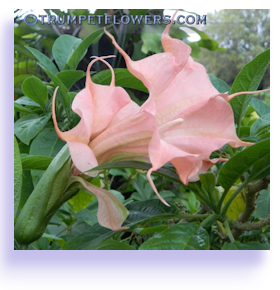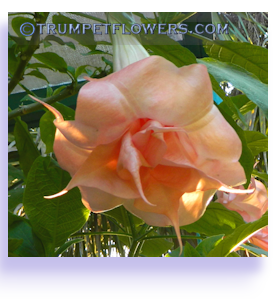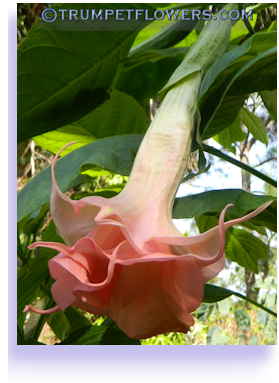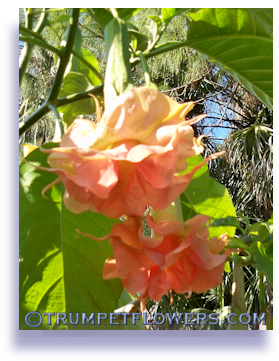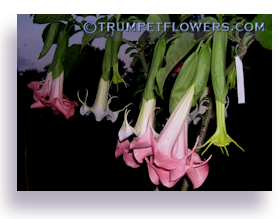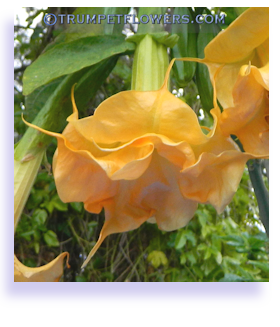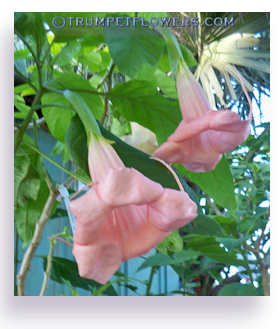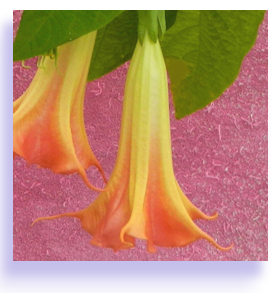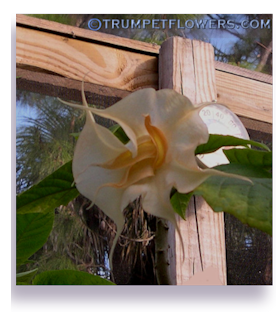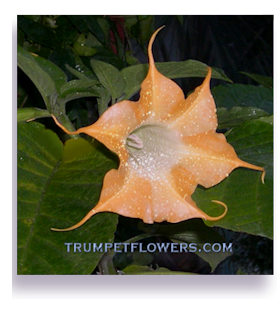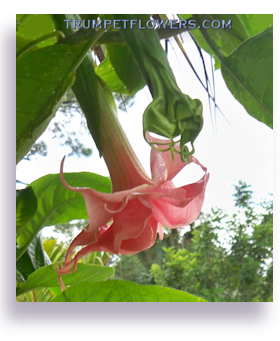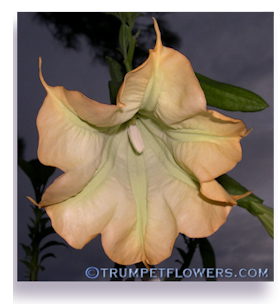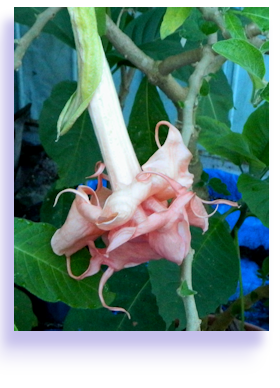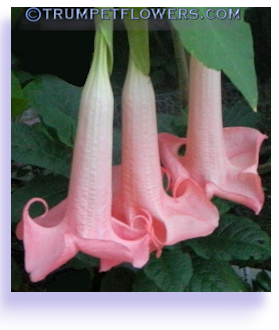Overwintering
Brugmansia
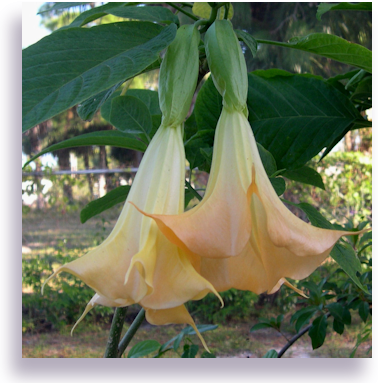 For Brugmansia fans that don't live in zones 9, 10 and 11, taking their prized brugmansia inside to overwinter is a regular occurrence. Brugmansia cannot take frost. The above ground growth will simply turn to mush. But, there are several ways to protect them during the frost and freezing times, some very inventive.
For Brugmansia fans that don't live in zones 9, 10 and 11, taking their prized brugmansia inside to overwinter is a regular occurrence. Brugmansia cannot take frost. The above ground growth will simply turn to mush. But, there are several ways to protect them during the frost and freezing times, some very inventive.
If you are not sure which hardiness zone you live in, here is a link to these maps, for all over the world. Then you can come back and read more information on what to do for your zone. Hardiness Zone Maps for All around The World
Cold Hardy Brugmansia?
I do get asked if there is a such thing as a true cold hardy brugmansia. Plain and simple, No. They will all die down to the ground. Brugmansia Hybridizers have been working for many years on this, and are always working towards discovering that special genetic code in a new grown from special cross seed, angel trumpet that can actually live through a freeze. In the meantime, there are some brugmansia that have been tried in microclimates, and may fare better than other cultivars. (These might do well in a cross breeding program) Here is a letter sent me by a gentleman in Alabama who grows many brugmansia and has plenty of experience with them. His letter is used with his pemission, of course.
"If you ever have inquiries about Brugs that are pretty cold hardy I can highly
recommend "Hawaiian Double White". I've had that one for years planted in the
ground and she comes back every year. She dies down after a couple of hard freezes
and I just cut it off to the ground and by early Summer she's going like gangbusters
again. Beautiful Dbl white with a good fragrance too. Also, Dr. Seuss and Pink Perfektion
have been pretty cold hardy here too. The rest of my Brugs I keep in pots."
Regards,
David C.
David also added: "I live at the bottom of zone 7B but only about one or two counties above zone 8A (Hoover, Al- suburb of Birmingham) and I must be sort of right in a sweet spot for growing a diverse range of plants."
Some Brugmansia Gardeners plant their angel trumpets directly into the ground in spring, only to dig them up in the fall. Others leave them in large containers and then sink them to ground level, hauling them up at the end of the growing season. Still others leave them in large containers and enjoy them on the patio for the spring and summer, hauling them inside come cold temperatures.
If you live in zone 9, you can treat the angel trumpet as an annual, allowing it to die back when a good frost occurs. Mark the spot and in spring, continue watering and fertilizing. It will spring back quickly, and even bloom that very year, with a stringent fertilizing routine. If it is a winter with only very light frost, the Angel trumpet may actually survive, burning only a few leaves and not killing the semi-hard trunk. In these instances, throw a cloth comforter over the Brugmansia, and make sure to secure the bottom. This way you will not even lose the leaves.
But zones 8B and lower numbered, trim the angel trumpet back for a few cuttings to take inside and overwinter. In zone 8, it will most likely bounce back in spring, but I would cover myself with those rooted cuttings. Heavily mulch the base of the Angel, to protect those roots.
Zone 9'ers can also just cover the plant with a breathable sheet for the few evenings of light frost that occur, and the plant should survive. This will keep the top growth alive, and allow the plant to grow even bigger each year. Placing the angel trumpet tree up next to a building or home will also help keep it warmer, and ensure that it live through light frosts that are most common in zone 9. Make sure the sheet is tucked up good against the base of the tree, holding it down with stones or some other wind proof object. Mulch the plant well with pine needles or fallen leaves before wrapping it in the sheet.
You can also wrap a string of electrical or LED's Christmas lights around the base and tree that is tucked under the sheet. This nice little trick can provide enough warmth for the Angel trumpet to survive that frost and grow on another day! Read below in the comments section how a very creative lady in Zone 5 has been able to save her in-ground brugmansia!
If your Angel Trumpet has already been hit by frost, and is beginning to display soft branches and dying leaves, do not go ahead and trim it. Wait until Spring, after the threat of your last frost has passed. If you are able, dig up the root ball and transfer it to a warm basement or garage. Allow it to over winter here. If you can't dig it up, protect it with several cloth sheets thrown over it, and mulch the base of the Brugmansia heavily (dry mulch). In Spring, cut loose the dead material to expose healthy tissue. Cutting it too soon potentially exposes more good wood to more frosty conditions. Unless your environment is overly humid (not snow, water) and you have a healthy plant otherwise, it is best to wait until Spring to remove the frost damaged material.
Since I personally live in an almost frost free climate, I take to heart advice offered by experienced Growers in Cold regions. Here is some pointers made by Jere, a Master Gardener in Texas. We have been emailing one another on the care of Brugmansia in frost conditions:
'Jere says:
Further to our freeze damage discussion, I thought I'd point out two additional protective measures that I've used with considerable success. One is the use of split, cylindrical pre-formed foam insulation of the type that's intended to wrap around exposed piping. It's particularly effective in protecting the growing tips of Plumeria -- the part most vulnerable to a freeze -- once you've removed the leaves. Plumeria grow much straighter than Brugmansias, of course, so it's a simple matter to slip them on and secure them. With Brugmansias I sacrifice the plant tips but protect more of the trunk and large branches. The other is the use of a tomato cage filled with leaves and pine needles to protect the bottom of the plant. Around here it's most commonly used to protect the graft union on citrus.'
Here is what I responded. Although talking about pruning, it is worthy to note here on the overwintering page simply to make your life easier when bringing them inside, or as Jere suggests, leaving them in the ground:
'Me:
Jere,
When we speak of protecting the Y, there are several things to take into consideration.
I guess it is the way One looks at the plant and it's growth in the coming season. I agree in protecting the initial trunk up to the point of Y. However, beyond the Y is questionable, even in my climate.
Let me reiterate. Since Brugmansia does her best blooming on green wood, cutting the plant (and thus creating clones from the cut wood) is (to me, at least) good practice.
If One continues to feed the pruned plant on a regular basis, (3 times a week, MiracleGro Tomato Plant food) she recovers quickly and the cut brug will give fantastic flushes in Summer and Fall, up until you anticipate your first frost, when I would cut the plant to the first node (above) the fork.
Since you work with an Organization that clones them, this might become standard practice, if it is not already.
You being a Master Gardener, may already know this, I am not trying to sound out of place. Just wanted to tell you what I have learned of keeping Brugmansia. :)
Thank you for allowing me to publish your knowledge with the plant. I think it will help many growers. I get a lot of visitors to the overwintering page.
'
I would like to add to this, in my climate, Brugmansia blooms her absolute best in winter. This beautiful plant loves cool weather, and your best blooms occur when temperatures are above 55° but not over 75°.
No matter which way you enjoy your blooming brugmansias, come late fall, it is time to start preparing to get them protected. And for the remaining lower numbered zones, there are many other options for keeping your brugmansia alive and well through the winter months.
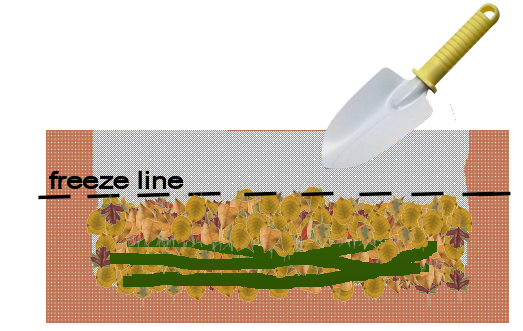
If you have no basement or garage, think about trying this trick to overwinter. And this way is quite simple, so I will list it first. It works very well for those who let the plants grow out in the ground, but live in zone 8 and lower. Simply dig a trough that is deeper than the freeze line by an extra 1 to 2 feet, and about 2 or so feet long. Cut your brugmansia into approximate equal pieces, making sure to permanently label each of them in some way. Set them beside the trough you have dug.
Now place some dampened unmilled sphagnum moss in the bottom of the trough, about 4 to 6 inches thick, covering the entire length. Place the labelled angel trumpet cuttings on top of it. Continue cutting and labelling, and filling the trough until you are done, making sure the last cuttings on top are still below the freeze line. Also be sure to pack some more dampened sphagnum moss inbetween as you go along. When you have all the cuttings in the trough, cover with another layer of sphagnum, and begin to shovel the soil from the digging back into the trough, until it is completely levelled off. Firm the trough and mark the spot. In spring and after you know the last frost is gone, dig up your cuttings and begin rooting them for the new season.
One point to remember here, is that you want the cuttings slightly damp, but not wet. Too much water will rot the cuttings. So slight moisture is what we are looking to acheive. Do not drench them.
When thinking of bringing brugmansia inside, as these other methods deal with, be sure to first spray with water the angel trumpets very well, to dislodge any insects or other critters that might want to overwinter in your house. The link provided above will tell you more about controlling insect pests of brugmansia. Do this several times, and make sure to get the undersides of the leaves too, where many pests tend to hide. Only then, should you begin bringing the plant into your home for winter. If you plan on using any chemical treatments, you can do now too.
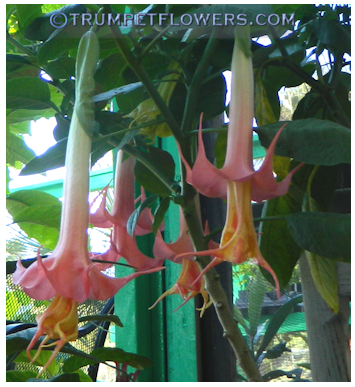 There are many who bring their Angels, roots and all; into their garage or basement in winter. Here they will allow the plants to go dormant, barely watering them until spring. They quit fertilizing them at the end of August, to allow the plant to slow down when being brought inside within a month or so. Even in these slowed down conditions, the plants are given lighting of some kind.
There are many who bring their Angels, roots and all; into their garage or basement in winter. Here they will allow the plants to go dormant, barely watering them until spring. They quit fertilizing them at the end of August, to allow the plant to slow down when being brought inside within a month or so. Even in these slowed down conditions, the plants are given lighting of some kind.
 Garage keeping Tip: If your garage stays too cold to use, try buying sheets of styrofoam from Lowes and lining the garage door with it. Styrofoam sheets come in 4 X 8 foot pieces, cut easily with a sharp knife, and will fit right into the inner side of the garage door panels. They will add no weight, and insulate the garage from potential freezing. Glue them in with Liquid Nail, found by the caulk tubes. Make sure that the garage door's bottom seal is tight, or your whole endeavor is moot.
Garage keeping Tip: If your garage stays too cold to use, try buying sheets of styrofoam from Lowes and lining the garage door with it. Styrofoam sheets come in 4 X 8 foot pieces, cut easily with a sharp knife, and will fit right into the inner side of the garage door panels. They will add no weight, and insulate the garage from potential freezing. Glue them in with Liquid Nail, found by the caulk tubes. Make sure that the garage door's bottom seal is tight, or your whole endeavor is moot.
Some even further north cut the brugmansia while outside, place them in large 5 gallon buckets with water in the bottom, and let them go dormant without roots. Placing sphagnum moss in the bottom of the 5 gallon buckets helps. Only water when needed, and stop feeding. Make sure they have some kind of lighting in this situation as well. Of course, these prepared cuttings are brought into a warmer environment, be it a greenhouse, the basement, a warm garage or even a large kitchen or mudroom.
You can also turn them into direct cuttings. These can be set upright (always do cuttings in the right growth direction) in damp unmilled sphagnum moss that has been watered with fertilizer and Superthrive added. Do not over water them, but make sure to check on them to make sure they are rooting into the sphagnum. Weakly fertilize to keep them alive through the winter months. If you are unsure of how to take proper cuttings, read this page I wrote on Taking Stem cuttings. This will make sure that you have cuttings that have rooted and you can replant for the next year.
Still another way of bringing in the brugs has to do with downsizing the pots. Remove them either from the ground, or the large planter you had it in. Cut down the root ball by a third, and do the same to the tops. Place in a smaller pot to conserve size. In spring, you can up the pot size again to get them going again. Garage keeping in winter is often done with this method, just make sure your garage does not dip below freezing.
Pests can be a problem, even in winter. Many people complain of whiteflies and ants inside their homes, and on their brugs; come overwintering in the home or garage. Because you are dealing with an indoor condition, you will need to try and fight back organically. Use sprays like Neem Oil to control the insects inside, and be faithful with repeat sprayings.
You could also try keeping them warmer than normal (if you have the room to allow them to grow) and continue to give them weak fertilizer. Giving the brugs this continuation of growth may make them more resistant to pests through cold winter months.
So, by burying, by cutting, by downsizing, and all of the other ways, you can grow brugs, no matter what climate you live in!
Note:
For more about the precise way to pot up a brugmansia, you can read the this section on Repot Brugmansia. Just remember your purpose is to bring them in and repot to a smaller size, not get them growing. But the princibles are the same. And if you do not know how to prepare cuttings, read my page How to properly prepare stem cuttings..
For different methods of pruning, you can read Pruning a Brugmansia.
When the end of winter starts to roll around, and it is time to wake your brugmansia back up, you can try some of the tips on the page Revitalize Your Brugmansia You may have gotten a few pests on it through the winter months and this page can help. You can also read Get Brugmansia Blooming!

Tags: overwintering brugmansia, Overwintering brugmansia, over winter angel trumpets, protect angel trumpets, overwintering angel trumpets, frost free brugmansia, brugmansia overwinteren, frozen brugmansia, frozen angel trumpets, trim,
This entry was posted on February 10th, 2012 and is filed under Brugmansia Information.

